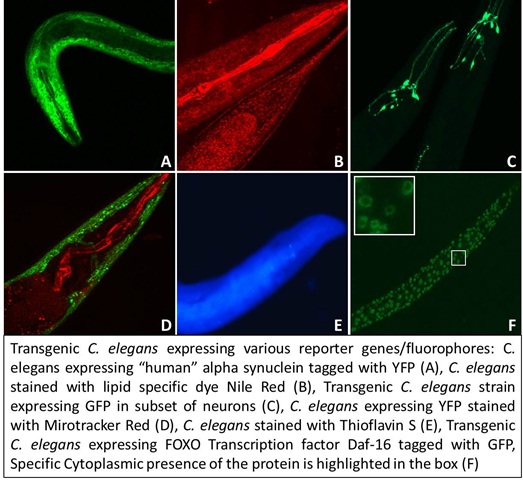We employ model system C. elegans for our studies and make use of genetic and pharmacological interventions including RNAi induced gene silencing, transgene constructs (GFP/YFP), Transcriptome analysis, micro RNA expression studies and associated aspects related to protein aggregation, cellular signaling and neuronal cell death, towards understanding mechanistic aspects related to human Alzheimer’s and Parkinson’s disease. Our laboratory is equipped with state-of-the-art facilities including High end C. elegans workstations with Stereozoom microscopes and imaging tools, C. elegans culture room equipped with customised sterile cabinets, Bacterial culture facility with Class II Biosafety cabinet, Automated fluorescence microscope with imaging system, Genetic microinjection system for C. elegans, PCR, Real time PCR, Multimode plate reader with Fluorescence/Luminescence/Absorbance suites, Electrophoresis/Blotting facility and all necessary infrastructural setup required for carrying out cloning, expression and transgenesis related studies. We are also maintaining a repository of 90+ transgenic and knockout mutant strains of C. elegans and an RNAi library of ~17,000 bacterial clones required for silencing 85% of the genome of C. elegans. The laboratory also has access to institutional Confocal microscopy, Multi-photon microscopy, NextGen sequencing (Ilumina MiSeq), Microarray, 2D DIGE and multiple other facilities that are required for addressing the specific aims of our studies

➤ Highlights of our recent research work:
A Systematic RNAi Screen of Neuroprotective Genes Identifies Novel Modulators of Alpha-Synuclein-Associated Effects in Transgenic Caenorhabditis elegans
Parkinson's disease (PD) is the second most common progressive neurodegenerative disorder, defined clinically by degeneration of dopaminergic neurons and the development of neuronal Lewy bodies. Current treatments of PD are inadequate due to a limited understanding of molecular events of the disease, thus calling for intense research efforts towards identification of novel therapeutic targets. We carried out the present studies towards identifying novel genetic modulators of PD-associated effects employing a transgenic Caenorhabditis elegans model expressing human alpha-synuclein. Employing a systematic RNA interference (RNAi)-based screening approach, we studied a set of neuroprotective genes of C. elegans with an aim of identifying genes that exhibit protective function under alpha-synuclein expression conditions. Our results reveal a novel set of alpha-synuclein effector genes that modulate alpha-synuclein aggregation and associated effects. The identified genes include those from various gene families including histone demethylase, lactate dehydrogenase, small ribosomal subunit SA protein, cytoskeletal protein, collapsin response mediator protein, and choline kinase. The functional characterization of these genes reveals involvement of signaling mechanisms such as Daf-16 and acetylcholine signaling. Further elucidation of mechanistic pathways associated with these genes will yield additional insights into mediators of alpha-synuclein-induced cytotoxicity and cell death, thereby helping in the identification of potential therapeutic targets for PD.
Potential role of protein stabilizers in amelioration of Parkinson's disease and associated effects in transgenic Caenorhabditis elegans model expressing alpha-synuclein
Protein stabilizers/chemical chaperones/osmolytes find significant industrial application in maintaining the native state of proteins and averting their misfolding or aggregation during repetitive freeze-thawing and various other stresses. Existing literature presents evidence towards possible therapeutic benefits of these protein stabilizers in evading or delaying disorders arising from protein misfolding and aggregation, usually termed as proteo-pathies. Parkinson's disease (PD) is one such disorder marked with alpha synuclein aggregation forming inclusions resulting in dopaminergic neurodegeneration and impaired motor function. We carried out this study in order to delineate the potential of protein stabilizers in attenuating manifestations associated with parkinsonism using a transgenic Caenorhabditis elegans model expressing human alpha synuclein. We studied protein stabilizers sorbitol, trehalose and xylitol and evaluated various endpoints associated with alpha synuclein aggregation. Lower concentrations of protein stabilizers were inefficient in exhibiting any effect, however a higher concentration (10 mM) did exhibit a significant effect on the studied phenotypes. Trehalose, at 10 mM concentration, showed reduction in alpha synuclein levels and reactive oxygen species, while showing significant increase in motility, dopamine levels and up-regulation of autophagic and chaperonic genes bec-1, lgg-1, epg-8, hsp-60 and hsp-4 in alpha synuclein expressing model, implicating its beneficial effects in parkinsonism. Our studies established the potential role of trehalose in alleviating manifestations associated with parkinsonism via its inherent activity and through induction of autophagic machinery in vivo. We conclude that these chemical chaperones have potential in being used as a supplementary therapeutic intervention addressing the important factor of protein aggregation in neurodegenerative Parkinson's disease. Further research on the subject will be required towards establishing their mechanism of action and suitability of such intervention, possibly along with existing therapies that address other important factors of the disease.
Ida-1, the Caenorhabditis elegans orthologue of mammalian diabetes autoantigen IA-2, potentially acts as a common modulator between Parkinson's disease and Diabetes: role of Daf-2/Daf-16 insulin like signalling pathway.
The lack of cure to age associated Parkinson's disease (PD) has been challenging the efforts of researchers as well as health care providers. Recent evidences suggest that diabetic patients tend to show a higher future risk for PD advocating a strong correlation between PD and Diabetes, thus making it intriguing to decipher common genetic cues behind these ailments. We carried out studies on ida-1, the C. elegans orthologue of mammalian type-1 diabetes auto-antigen IA-2 towards achieving its functional workup vis-à-vis various associated endpoints of PD and Diabetes. Employing transgenic C. elegans strain expressing "human" alpha synuclein (NL5901) under normal and increased glucose concentrations, we studied aggregation of alpha synuclein, content of dopamine, expression of dopamine transporter, content of reactive oxygen species, locomotor activity, nuclear translocation of FOXO transcription factor Daf-16, and quantification of Daf2/Daf-16 mRNA. Our findings indicate that ida-1 affords protection in the studied disease conditions as absence of ida-1 resulted in higher alpha-synuclein aggregation under conditions that mimic the blood glucose levels of diabetic patients. We also observed reduced dopamine content, decreased motility, defective Daf-16 translocation and reduced expression of Daf-2 and Daf-16. Our studies establish important function of ida-1 as a modulator in Daf-2/Daf-16 insulin like signalling pathway thus possibly being a common link between PD and Diabetes.